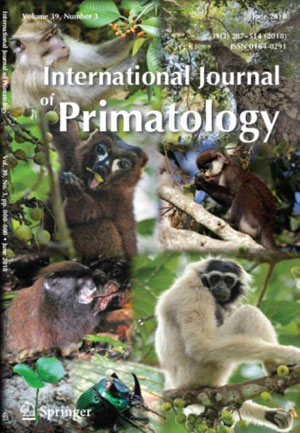Japanese
International Journal of Primatology Special Issue
Advances
and Frontiers in Primate Seed Dispersal

Title: Advances
and Frontiers in Primate Seed Dispersal
Editors: Onja Razafindratsima, Hiroki Sato, Yamato Tsuji, Laurence Culot
ISSN: 0164-0291
For many angiosperms, seed dispersal by frugivorous animals is a key process
for seed movement to new environments, species survival, and regeneration.
Primates are considered one of the main seed dispersal agents in tropical forest
ecosystems because they constitute a large proportion of the frugivore biomass
in the tropics. Their contribution to seed dispersal, and ultimately to plant
survival and forest structure, has been studied since the 1980s. In 1998, the
journal American Journal of Primatology published a Special Issue on primate
seed dispersal, introducing progress in this research area at that time. Twenty
years have passed since that milestone, and technological innovations, new
theories, and a shift from species-based to community-based approaches in seed
dispersal study have influenced primatologists and the study of primate seed
dispersal. Now is the time to reflect on the progress of studies on primate seed
dispersal over the past two decades, and identify patterns and directions for
the next decade. This Special Issue stems from a general interest among
researchers who presented their work on primate seed dispersal at the symposium
titled "Advances and Frontiers in Primate Seed Dispersal", organized
by Yamato Tsuji and Hiroki Sato, at the joint meeting of the International
Primatological Society and the American Society of Primatologists in Chicago,
Illinois, USA in August 2016. This issue presents research papers and reviews
that illustrate different aspects of seed dispersal by primates, from pre- to
post-dispersal phases. It brings together a collection of articles that extend
our knowledge of primate seed dispersal globally (from Africa, Asia, Madagascar,
and Neotropics), review what is known, and identify commonalities across
geographic locations, intercontinental and taxonomic differences, and gaps in
our understanding of primate seed dispersal.
https://link.springer.com/journal/10764/39/3/page/1
In this issue
Advances and Frontiers in Primate Seed Dispersal
Onja H. Razafindratsima, Hiroki Sato, Yamato Tsuji… Pages 315-320
Primate Fruit Color: Useful Concept or Alluring Myth?
Kim Valenta, Omer Nevo, Colin A. Chapman Pages 321-337
The Ecology and Evolution of Fruit Odor: Implications for Primate Seed
Dispersal
Omer Nevo, Kim Valenta Pages 338-355
Macaques as Seed Dispersal Agents in Asian Forests: A Review
Yamato Tsuji, Hsiu-Hui Su Pages 356-376
Predictions of Seed Shadows Generated by Common Brown Lemurs (Eulemur fulvus)
and Their Relationship to Seasonal Behavioral Strategies
Hiroki Sato Pages 377-396
Primates and Dung Beetles: Two Dispersers Are Better than One in Secondary
Forest
Laurence Culot, Marie-Claude Huynen… Pages 397-414
Consequences of Lemur Loss for Above-Ground Carbon Stocks in a Malagasy
Rainforest
Onja H. Razafindratsima, Anecia Gentles… Pages 415-426
Primate Seed Dispersal and Forest Restoration: An African Perspective for a
Brighter Future
Colin A. Chapman, Amy E. Dunham Pages 427-442
Primate Seed Dispersal: Old and New Challenges
Ellen Andresen, Victor Arroyo-Rodriguez… Pages 443-465
Seed Dispersal by Primates in Asian Habitats: From Species, to Communities,
to Conservation
Kim R. McConkey Pages 466-492




